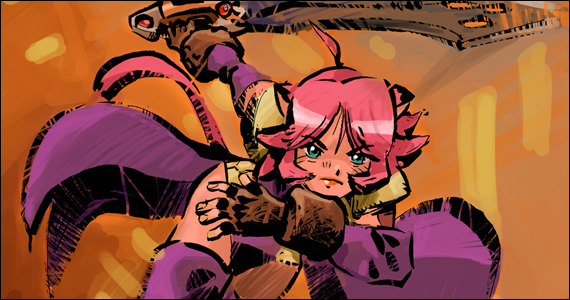
Krome Studios’ upcoming side-scroller about a pink haired cat-girl weilding a rather large sword hasn’t had to work too hard to stay on my radar this year. Based on an original IP that was first developed as a comic, and name dropping 2D inspirations like Strider are easy paths to the center of my heart, but also only part of the picture on what we should expect.
In June Atari stepped up as publisher, stretching the title’s reach to include PlayStation Network, Xbox Live Arcade and PC download for this Fall, so it seemed like a good time to hit the team up with some of the questions I’ve gathered since first hearing about the game, which Krome Studios’ Co-Founder and Creative Director Steve Stamatiadis was good enough to take the time to answer.

Gamesugar: I’m under the impression that Blade Kitten was a comic first specifically to gain support for game development, and I wanted to ask about whether there were gains from the comic work that proved invaluable and worthwhile in hindsight?
Steve Stamatiadis: The comic ended up being pretty invaluable. It gave the team a broad range of elements to use as a guide when they needed direction. For example when we needed to work out the look of various effects I could point to a panel on a printed page and say “let’s start with that”. It’s like working on an established license, like we did previously on Star Wars: The Force Unleashed but with the ability to have full say over what’s important.
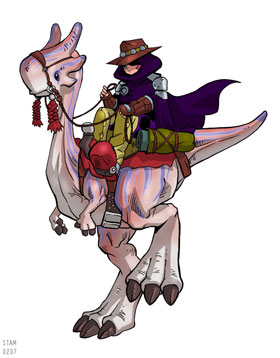
GS: Given that Blade Kitten was a comic first, what was the process like fitting everything created into a game?
SS: Early on I decided that it would be a better idea to make a more self contained story than to try to recreate the story I was working on in the comic. So it was more a matter of picking and choosing the elements I wanted to use for the game rather than trying to fit everything in. It also gave me the freedom to come up with new characters and locations to tell the story in the best way possible.
What DID come across was a lot of the feeling of the comic, things like Kit’s smart mouth, her relationship with Skiffy, the humor. Those elements were actually trickier to get right than you might think and those were areas we spent time on.
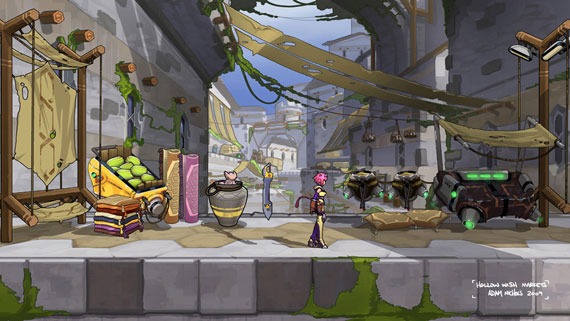
GS: In conversations with other game designers, I often hear that the best gaming experiences are rooted in a project that strives for fun and engaging sequences prior to visual designs and narrative concerns. Many of those same people tell me that a major problem in the industry today is that the opposite is more often the case.
It’s my favorite chicken and egg question so I have to ask, what came first in designing Blade Kitten, the best experience for the player or fitting the flow of the game to the pre-established content?
SS: I don’t think they’re mutually exclusive. It might be the case that it’s a problem when those elements don’t have any unifying link. I think being a smaller project and having the designer also be behind the visual style and narrative gives you that unity. Many of the elements in the comic were designed to be used as functions of gameplay – I really got to cheat that in a way most designers never could. I also know how much wriggling room there is in comic elements that can be changed to make the game better.
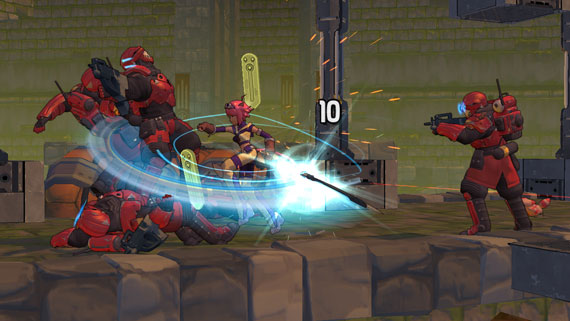
GS: A recent post on the PlayStation Blog mentioned that this was your first download title, and more importantly your first side-scrolling game, also mentioning the challenge of sizing stages for a download title.
What I’m deadly curious about is how you approached the more intricate aspects of a side-scroller, such as the feel of movement through the controls, the way that movement plays into combat with enemies, the kind of stuff that either keeps us replaying this for years or has you frowning at a review after release?
SS: Technically, while it was the team’s first side-scroller my first was “Halloween Harry / Alien Carnage” from way back in the early ‘90s. For me Blade Kitten is a return to my roots. That said, doing a 2D game in 3D is a whole new challenge. From day one my mantra was flowing gameplay: I never wanted the staccato movement feel you get from when the player character changes states like going from a run to climbing a ladder to getting off (I’m looking at you, original Donkey Kong).
GS: That same post mentioned Strider as an influence, which struck some holy ground for me. What are the elements about a classic game such as Strider that you really wanted to tap? Are there other influences or inspirations you want to give a nod to?
SS: To me Strider is still one of the best embodiments of an action movie in game form. I’ve always loved the simple combat and the ability to make your way around the levels. The cool flip over jump, slide attacking enemies, the sidekicks. And how can you not love the fact that you didn’t know what was coming next in a level. Other inspiration games include Legend of Kage, Ninja Spirit, Super Castlevania IV, Haunted Castle (the Arcade Castlevania) and Ninja Warriors. That’s a lot of ninja games come to think of it but I guess if you want a character to jump around you can’t beat a ninja.
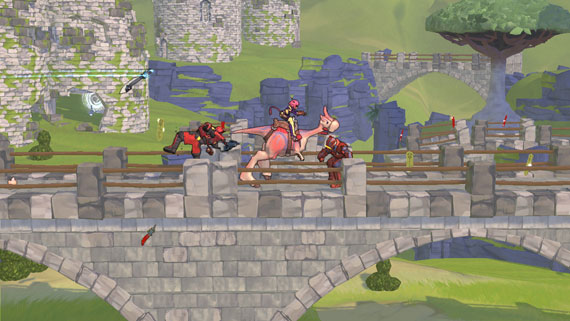
GS: So Blade Kitten has several blades players can purchase within the game with different attributes. Would you believe the number one question people ask when I’ve mentioned that is just how different those attributes are?
SS: They’re not radically different but they do vary damage, speed and some of your abilities like special moves. Each does have its own unique critical attack sequence which is fun and looks awesome. There are four blades in the first episode and three in the second.
GS: The color palette immediately hit me as pretty bubblegum fantastic, which was pretty refreshing and bold the first time I saw it. How much of a consideration was that in the design? Are you aiming to slap people upside the eyes?
SS: I have no fear of color. I don’t think grey equals mature or next generation. That might come from living in bright sunny Australia where you look outside and the world is amazingly colorful. The artist who worked on other concepts and lighting understands that you can have a colorful world that fits together visually without having to go mono-tonal. That also allowed us to use color to signify elements of gameplay – for example Kit’s Pink hair color is only ever used on elements that apply to Kit like the HUD. If you’re going to have a crazy color like that you want to make sure it’s special.
So yes I guess we are trying to slap color back into people’s gaming lives. But remember folks we’re trained professionals, don’t try this at home without a copy of the game Blade Kitten on PlayStation 3, Xbox 360 and PC. (Woah, that was my lamest plug ever!)